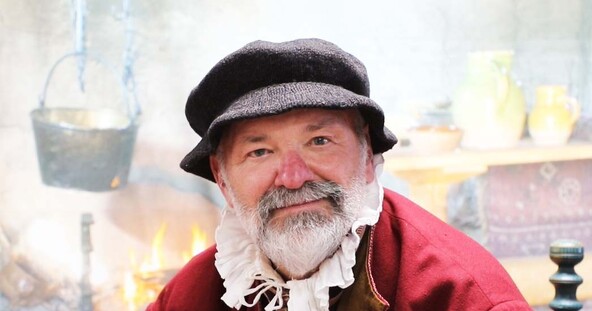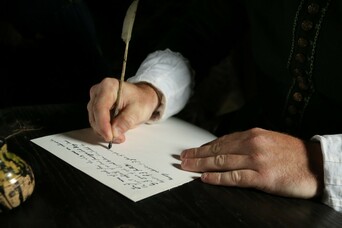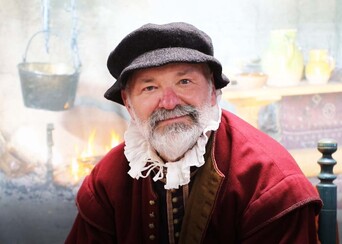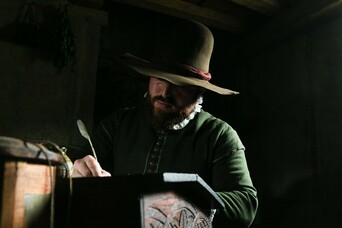
Primary Sources
Primary Sources
How do we bring history alive for today’s learners? We start with primary sources - the building blocks of history! Primary sources can include written documents, archaeology, material culture, landscapes, oral histories, artworks and photos. These are important tools that let us shed light on 17th-century history and understand the experiences from different perspectives. Here are a few of the primary sources we use every day.
Of Plimoth Plantation

Written by William Bradford, Of Plimoth Plantation (1651) is considered by many to be one of Massachusetts’ – and indeed the Nation’s – greatest treasures. The book details the major events in the lives of a small group of religious Separatists, known as the Pilgrims, who set out from England to seek the religious freedom they felt was not available to them back home. Bradford presents in manuscript format the authoritative account of the Mayflower voyage, relationships with 17th-century Indigenous communities, and the settling of what would become the first permanent European colony in New England, using the Mayflower Compact as its governing document.
Mourt's Relation

"A Relation or Journal of the Beginning and Proceedings of the English Plantation Settled at Plimoth in New England..." also known as Mourt's Relation was first published in 1622 to promote Plymouth and encourage more people to join the colony. The unknown authors wrote detailed descriptions of the events of 1620-1621 including the Pilgrims' exploration of Cape Cod in the winter of 1620-1621, building of the town, and the 1621 alliance of mutual protection which established diplomatic relations with the Pokanoket sachem Ousamequin (known by his title, Massasoit) and other Indigenous communities. Mourt's Relation also includes Edward Winslow's famous letter which describes the 1621 harvest feast now called The First Thanksgiving (see pg. 82). Perfect for teachers looking to explore early contact between Europeans and Indigenous communities.
Oral History
Oral History is the collection and study of historical and cultural information through storytelling. For many Indigenous communities, including the Wampanoag, the spoken word has enabled their history to be passed from generation to generation since time immemorial. Many Indigenous nations still have a yearly ceremony in which their history stories are once again told. Telling and listening to the oral history each year is an event taken very seriously. Everyone knows they are the new part of tribal history, and that to learn the past stories of their own People is to continue themselves and learn from the retelling of past events.
Good News From New England

Written by Edward Winslow, Good News from New England (1624)picks up the stories of Plimoth and Patuxet after the 1621 harvest feast and features descriptions of the difficult first years in Plymouth Colony, including the arrival of new colonists as well as moments of collaboration and conflict with Ousamequin and other Wampanoag and Massachusetts sachems. This easy-to-read pamphlet also includes Winslow's 17th-century observations of the local climate, detailed descriptions of Wampanoag manners, customs, and cultural lifeways, and conversations Winslow reported having with Ousamequin and other Wampanoag leaders during diplomatic trips. Perfect for teachers looking to introduce primary sources and explore history from multiple perspectives!
Additional Primary Sources
William Wood's New England's Prospect (1634)is one of the first published accounts of life in New England and includes commentary on everything from geography and diversity in plant and animal life to descriptions of daily life for New England's colonial and Indigenous populations. Wood also includes a short vocabulary of every-day Algonquian words, including place names.
Wampanoag oral tradition, history, and culture are deeply intertwined with place. These language resources are provided courtesy of the Wôpanâak Language Reclamation Project and are a great resource for teachers looking to incorporate conversations about maps, place, and community identity into their classroom studies.
Thomas Morton's three-volume history, natural history, satire, and poetry New English Canaan (1637) offers an alternative, critical perspective on early Puritan and Separatist-led colonization efforts in New England as well as a critique of their treatment of Indigenous populations. Morton also wrote extensively about his observations of Massachusetts people's daily life including architecture, clothing, manner, trade, etc. in what is today Quincy, Massachusetts. This primary source would be good for ELA and History/Social Studies comparison activities exploring different English perspectives on colonization.
Sustained English missionary outreach among the Wampanoag, Massachusett, Nipmuc, and other Indigenous communities in southern New England began in 1646 led by the ministers John Eliot and Thomas Mayhew with financial and political support from Oliver Cromwell's sympathetic Puritan Commonwealth of England. In 1649, Parliament passed "An Act for the Promoting and Propagating the Gospel of Jesus Christ in New England" which created a charitable organization to fund missionary projects in New England including translating the Bible and other scriptural texts such as catechisms into Algonquian languages and setting up "praying towns" for newly converted "praying Indians" complete with churches. Church membership in Massachusetts required a confession of faith - a public demonstration of the individual's understanding of Christian doctrines and theologies. Tears of Repentance (1653), details confessions made by Nipmuc, Massachusett, and Wampanoag converts that were recorded and printed to demonstrate the missionaries' progress. Recorded in the first person, these emotional declarations allow historians to hear individual Indigenous voices from the 17th century as they grapple with conversion.
This compilation of letters written by former Secretary to the Governor and Council of Virginia John Pory, English adventurer Emmanuel Altham, and Dutch West India Company official Isaack de Rasieres offer a series of unique descriptions of Plymouth Colony in the 1620s. These letters are also a great primary resource for teachers who want to compare how Virginia, Plymouth, and Dutch New Netherlands thought about the natural world, negotiated with Indigenous People, and managed inter-colonial trade.
This website is great for teachers looking to include a study of contemporary Indigenous communities in their class or unit. On this website you will find links to various tribal groups recognized by the Commonwealth of Massachusetts as well as other government agencies who partner with tribal leadership to provide resources including health care.
The Bureau of Indian Affairs is a federal agency whose mission is to enhance the quality of life, to promote economic opportunity, and to carry out the responsibility to protect and improve the trust assets of American Indians, Indian tribes and Alaska Natives. This website provides information about the 574 federally recognized tribes in the United States and the services they provide to 1.9 million American Indian and Alaska Natives including economic development, education, health care, and safety and risk management. This website is a good resource for teachers exploring aspects of contemporary life for Indigenous communities across the country and and the evolving relationships between federal and tribal governments.
In 1662, Phineas Pratt presented to the General Court of Massachusetts a narrative entitled “A Declaration of the Affairs of the English People that First Inhabited New England” to support his request for financial assistance. The extraordinary document is Pratt’s own account of the Wessagusset settlement and its downfall.
Records of Plymouth Colony's colonial government include over 70 years of legislative notes from meetings of the General Assembly and an assortment of trials and cases heard in Plymouth Colony from 1634-1691. These resources are perfect for teachers looking to explore civics and government in Plymouth Colony as well as interactions between Indigenous and colonial English communities. These records include court cases in which Indigenous individuals were plaintiffs as well as Plymouth Colony's response to the Pequot War (1636-7), King Philip's War (1675-6). Court records are also a great resource for students looking to explore women's history, particularly using court records, wills, and probate inventories. The multi-volume records have been digitized and are available free to the public.
Plimoth Patuxet Museums maintains important archaeological and material culture collections related to pre- and post-contact Wampanoag Patuxet and Plymouth Colony. These collections inform and support the interpretation on our living history sites and inform historical and archaeological research.
Talk to a Museum Educator
Want to talk to a Museum Educator about ways you can use these 17th-century primary sources in your classroom? Email us at programservices@plimoth.org.